-

新人教版高中英语必修3Unit 4 Space Exploration-Listening&Speaking&Talking教学设计一
Listening and Speaking introduces the topic of “talking about how to become an astronaut”. This period is aimed to inform students some details about the requirements of being an astronaut. Students can be motivated and inspired by the astronauts. Teachers ought to encourage students to learn from them and let them aim high and dream big.Listening and Talking introduces the theme of "talk about life in space". This part also informs students more details about life in space and can inspire students to be curious about this job. 1. Guide students to listen for numbers concerning dates, years and ages etc2. Cultivate students' ability to talk about how to become an astronaut and life in space ; 3. Instruct students to use functional sentences of the dialogue such as “ first of all, I am not sure, so what might be .. I guess.. I wonder…I am curious…)appropriately.1. Guide students to understand the content of listening texts in terms of the whole and key details; 2. Cultivate students' ability to guess the meaning of words in listening; discuss with their peers how to become a qualified astronaut and describe the life in space.Part 1: Listening and SpeakingStep 1: Lead inPredictionThe teacher can ask students to predict what the listening text is about by looking at the pictures.About how to become an astronaut./the requirements of an astronautStep 2: Then, play the radio which is about an interview a. And after finishing listening for the first time, the students need to solve the following tasks.

新人教版高中英语必修3Unit 4 Space Exploration-Discovering Useful Structure教学设计
The theme of the section is “Describe space facts and efforts to explore space”. Infinitives are one of non-finite verbs, as the subjects, objects, predicative, attributes and adverbials. This unit is about space exploration, which is a significant scientific activity, so every scientific activity has strong planning. Therefore, using the infinitives to show its purpose, explanations or restrictions is the best choice.1. Learn the structure, functions and features of infinitives.2. Learn to summarize some rules about infinitives to show purpose and modify.3. Learn to use infinitives in oral and writing English. 1. Learn the structure, functions and features of infinitives.2. Learn to summarize some rules about infinitives to show purpose and modify.3. Learn to use use infinitives in oral and writing English.Step 1 Lead in---Pair workLook at the following sentences and focus on the italicized infinitives. In pairs, discuss their functions. 1. I trained for a long time to fly airplanes as a fighter pilot..(作目的状语)2. As we all know, an astronaut needs to be healthy and calm in order to work in space..(作目的状语)3. First of all, you must be intelligent enough to get a related college degree..(作目的状语)4. Some scientist were determined to help humans realise their dream to explore space..(作定语)5. On 12 April 1961, Yuri Gagarin became the first person in the world to go into space..(作定语)Summary:1. 不定式的结构:to+do原形。2. 分析上面的句子,我们知道在描述太空探索时,动词不定式不仅可以用来表目的,还可以用来作定语,表修饰。
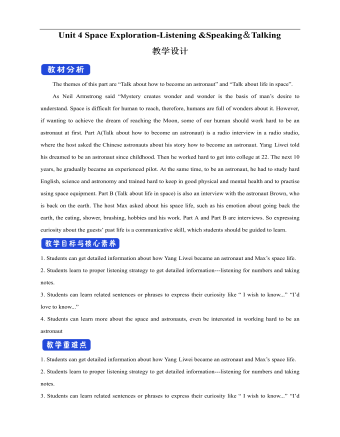
新人教版高中英语必修3Unit 4 Space Exploration-Listening&Speaking&Talking教学设计二
The themes of this part are “Talk about how to become an astronaut” and “Talk about life in space”. As Neil Armstrong said “Mystery creates wonder and wonder is the basis of man’s desire to understand. Space is difficult for human to reach, therefore, humans are full of wonders about it. However, if wanting to achieve the dream of reaching the Moon, some of our human should work hard to be an astronaut at first. Part A(Talk about how to become an astronaut) is a radio interview in a radio studio, where the host asked the Chinese astronauts about his story how to become an astronaut. Yang Liwei told his dreamed to be an astronaut since childhood. Then he worked hard to get into college at 22. The next 10 years, he gradually became an experienced pilot. At the same time, to be an astronaut, he had to study hard English, science and astronomy and trained hard to keep in good physical and mental health and to practise using space equipment. Part B (Talk about life in space) is also an interview with the astronaut Brown, who is back on the earth. The host Max asked about his space life, such as his emotion about going back the earth, the eating, shower, brushing, hobbies and his work. Part A and Part B are interviews. So expressing curiosity about the guests’ past life is a communicative skill, which students should be guided to learn.1. Students can get detailed information about how Yang Liwei became an astronaut and Max’s space life.2. Students learn to proper listening strategy to get detailed information---listening for numbers and taking notes.3. Students can learn related sentences or phrases to express their curiosity like “ I wish to know...” “I’d love to know...”4. Students can learn more about the space and astronauts, even be interested in working hard to be an astronaut
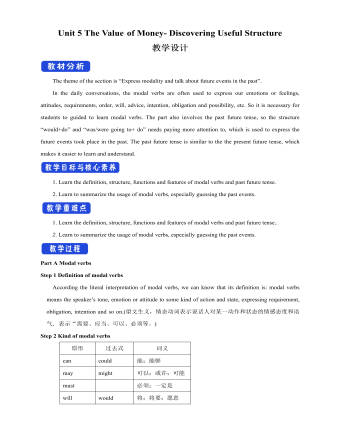
新人教版高中英语必修3Unit 5 The Value of Money- Discovering Useful Structure教学设计
Step 3 Meaning1. 过去将来时表示从过去某一时间来看将要发生的动作或存在的状态, 常用在宾语从句中。一般由“would/should +动词原形”构成。She hoped that they would meet again someday. 她希望将来有一天他们能再见面。2. was/were going to+动词原形: 表示过去将要发生或很有可能发生的动作, 常用于口语中, 表示预言、意图或者打算等。He was going to start work the following week. 他打算下星期开始工作。3. was/were about to do: 常用来表示即将发生的动作, “刚要/正要做……”。注意该结构不与任何时间状语连用。I felt that something terrible was about to happen. 我感到某种可怕的事情即将发生。4.was/were to do: 表示“曾计划做某事”, 如果表示“本来计划做某事, 动作没实现”, 则需用 “was/were to have done”。She said she was to have told me about the accident. 她说她本来想告诉我关于事故的事。5.Start, go, come, leave, see, meet等动词的过去进行时: 表示就过去某一时刻而言即将发生的动作。She was coming later. 她随后就来。I had just put on my overcoat and was leaving to visit a friend of mine. 我刚穿上外套要去看我的一个朋友。
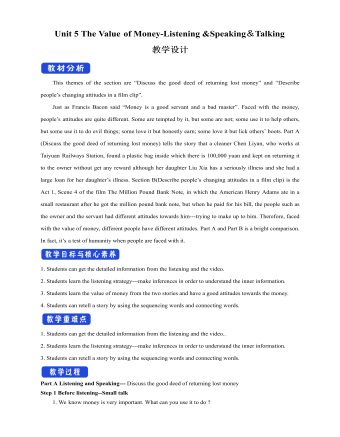
新人教版高中英语必修3Unit 5 The Value of Money-Listening &Speaking&Talking教学设计
4. A:We’d like to have someone to say a word at the beginning to welcome the group.B:↙Who?A:We thought that you or Dr.Johnson might do it.B用降调说Who,其意思是问,对方想让谁在开场时致欢迎词。Step 6 Pronunciation---Practice1. Listen to the short conversation and mark the intonation with ↗, ↙ or ↙, ↗. Then discuss with a partner what they intend to convey by using different intonation.Owner: You know what ?↗ It’s a million-pound bank note↙.Waiter 1: Really ?↗(question)Waiter 2: Really !↙(unbelievable and surprised)Waiter 3: Really ?!↙↗(first question then surprised)2. Listen to the conversations. Underline the parts that are stressed and mark the intonation. Then talk about the implied meanings of the responses with different intonations. Listen again and repeat.1) Henry: It’s a nice suit.Owner: Oh, it’s perfect!↙(The intonation means it is very suitable for Henry.)2) Henry: Well, that’s very kind of you.Owner: Kind, sir ?↗(what you said is not right) No, it’s kind of you. You must come whenever you want and have whatever you like. Just having you sit here is a great honour !!↙(welcome you to come again)3)Henry:Well, to be honest, I have none. Oliver:(happily) What luck!(excited) Brother↗, what luck!↙(It means “Didn’t you hear it?”)Henry: Well, it may seem lucky to you but not to me!↗(angry) If this is your idea of some kind of joke, I don’t think it’s very funny. Now if you’ll excuse me, I ought to be on my way.↙(If so, I would leave.)Roderick: Please don’t go↙...(hope Henry can wait for a moment)Part B Viewing and Talking---Describe people’s changing attitudes in a film clipStep 1 Before-listening---Tell the filmYou are going to watch part of the film The Million Pound Bank Note. Look at these photos and guess what happens in the film.
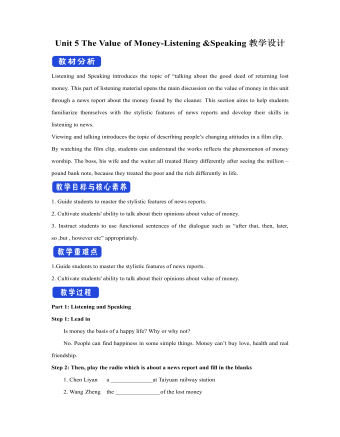
新人教版高中英语必修3Unit 5 The Value of Money-Listening &Speaking教学设计
Step 4: Listen again and decide if the following statements are true (T) or false (F).1 It was the first time Chen Liyan's story was reported. T口 F口2 Chen found 10,000 yuan in a small plastic bag in Taiyuan railway station口 F口3 Wang Zheng apologized to Chen because he couldn't offer her more money. T口 F口4 Chen took out a large loan to cure her daughter, T口 F口5 Wang set up a fundraising website for Chen's daughter after Chen told him about her situation. T口 F口Step 5:After listening, discuss the questions.1 What kind of person do you think Chen Liyan is?Chen Liyan is generous and honest because she returned a large sum of money to the owner.2 Did Chen return the money because she didn't need it?No. She returned the money because it was the right thing to do. Evidence for this is that she refused to accept the reward money because she felt that it had not been earned. 3 Is it common for people to do what Chen did?It depends on the culture. In some countries it is quite common to return money that has been found. In other countries, people believe "Finders are keepers!" 4 How did Wang Zheng feel about the return of his money?He must have been very happy and relieved to have gotten his money back. We know this because he thanked Chen repeatedly and even offered her a reward.5 Why did Ma Dongbao tell Wang about Chen's family?He must have had great sympathy for Chen and her daughter and wanted to help them.'We know this because he arranged help for them. 6 How did the news reporter feel about Chen's actions?The news reporter felt that it showed that money wasn't the most important thing in life. We know this because the reporter told us that this is what Chen believes. and then said, “that's a great attitude to take."

倾斜角与斜率教学设计人教A版高中数学选择性必修第一册
(2)l的倾斜角为90°,即l平行于y轴,所以m+1=2m,得m=1.延伸探究1 本例条件不变,试求直线l的倾斜角为锐角时实数m的取值范围.解:由题意知(m"-" 1"-" 1)/(m+1"-" 2m)>0,解得1<m<2.延伸探究2 若将本例中的“N(2m,1)”改为“N(3m,2m)”,其他条件不变,结果如何?解:(1)由题意知(m"-" 1"-" 2m)/(m+1"-" 3m)=1,解得m=2.(2)由题意知m+1=3m,解得m=1/2.直线斜率的计算方法(1)判断两点的横坐标是否相等,若相等,则直线的斜率不存在.(2)若两点的横坐标不相等,则可以用斜率公式k=(y_2 "-" y_1)/(x_2 "-" x_1 )(其中x1≠x2)进行计算.金题典例 光线从点A(2,1)射到y轴上的点Q,经y轴反射后过点B(4,3),试求点Q的坐标及入射光线的斜率.解:(方法1)设Q(0,y),则由题意得kQA=-kQB.∵kQA=(1"-" y)/2,kQB=(3"-" y)/4,∴(1"-" y)/2=-(3"-" y)/4.解得y=5/3,即点Q的坐标为 0,5/3 ,∴k入=kQA=(1"-" y)/2=-1/3.(方法2)设Q(0,y),如图,点B(4,3)关于y轴的对称点为B'(-4,3), kAB'=(1"-" 3)/(2+4)=-1/3,由题意得,A、Q、B'三点共线.从而入射光线的斜率为kAQ=kAB'=-1/3.所以,有(1"-" y)/2=(1"-" 3)/(2+4),解得y=5/3,点Q的坐标为(0,5/3).
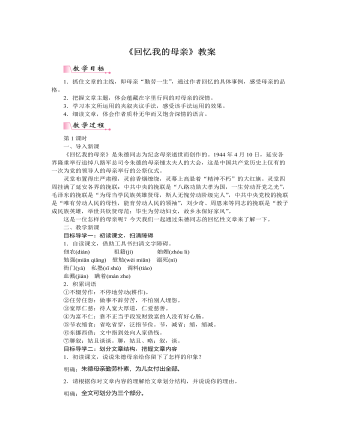
部编版语文八年级上册《回忆我的母亲》教案
这一句议论,呼应前文的记叙——母亲教“我”生产的知识,同情革命、支持革命,让“我”养成革命的意志。这些都是“我”感谢母亲的重要原因。“母亲是一个平凡的人,她只是中国千百万劳动人民中的一员,但是,正是这千百万人创造了和创造着中国的历史。”母亲勤苦一生,任劳任怨,反抗地主豪绅的欺压,坚强不屈,母亲就是一位普普通通的农妇,她是“平凡的”,但正是像母亲这样的千百万劳动人民,融汇成革命的洪流,推动着历史的发展,为我们的民族做出了不可磨灭的贡献,中国的现在、未来都将是劳动人民的。这句议论,将对母亲的深情与对民族、对广大劳动人民的深情融汇在一起。
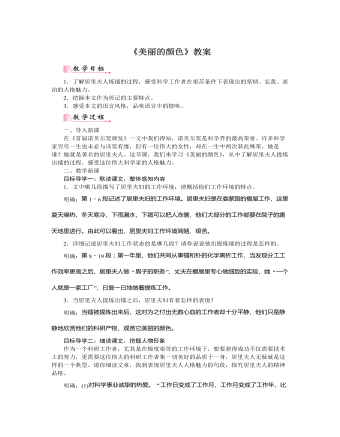
部编版语文八年级上册《美丽的颜色》教案
目标导学二:细读课文,把握人物形象作为一个科研工作者,尤其是在极度艰苦的工作环境下,想要获得成功不仅需要技术上的努力,更需要这位伟大的科研工作者集一切美好的品质于一身,居里夫人无疑就是这样的一个典型。请你细读文章,找到表现居里夫人人格魅力的句段,探究居里夫人的精神品格。明确:(1)对科学事业诚挚的热爱。“工作日变成了工作月,工作月变成了工作年,比埃尔和玛丽并没有失掉勇气。这种抵抗他们的材料迷住了他们。”其中的“迷住”一词突出表现了居里夫人对科学的痴迷和挚爱。(2)无惧一切困难,敢于将想法付诸实践。“最困难的,或者说几乎不可能的,乃是离析这极小含量的物质,使它从与它密切混合着的杂质中分离出来。”居里夫人选择最困难的工作,付出艰苦的劳动。(3)持之以恒、不轻言放弃。“工作日变成了工作月,工作月变成了工作年。”在这日复一日、年复一年的工作中,居里夫人终于提炼出了镭。
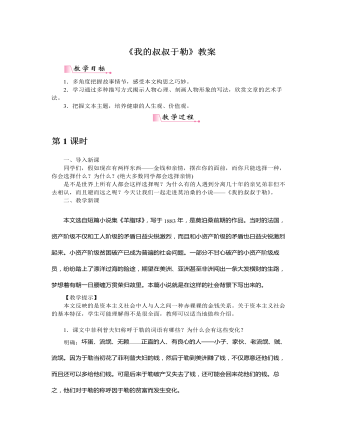
部编版语文九年级上册《我的叔叔于勒》教案
分析:“褴褛”一词是对于勒的外貌描写,点明他生活的贫困,处境的艰难。②他又老又脏,满脸皱纹,眼光始终不离开他手里的活儿。分析:再次描写于勒的外貌,充分说明他历尽磨难,饱经沧桑,穷困潦倒。③我看了看他的手,那是一只满是皱纹的水手的手。我又看了看他的脸,那是一张又老又穷苦的脸,满脸愁容,狼狈不堪。分析:第三次描写于勒的外貌,准确地表现出他此时的穷困潦倒,暗示他不幸的遭遇,竭力渲染他的悲惨境地。2.本文通过神态、语言、动作描写揭示人物心理活动,刻画人物性格,找出这些句子来进行分析。明确:菲利普认出卖牡蛎的穷水手就是于勒时,“突然好像不安起来”,这是心理骤然紧张所致;“他向旁边走了几步”,是想躲开于勒的目光,怕于勒认出自己来;“瞪着眼”看女儿、女婿,是怕他们察觉出这个秘密。这一系列神态、动作描写,层次分明地写出了人物紧张、恐慌以至失魂落魄的心理状态。
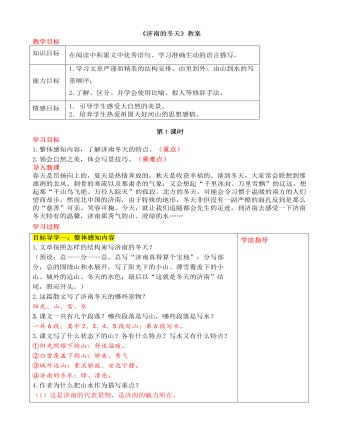
部编版语文七年级上册《济南的冬天》教案
目标导学二:体会写景技巧1.第一段作者用什么写作手法写出济南冬天“温晴”的天气特点,有何好处?通过和北平冬天多风、伦敦多雾、热带日光的毒和响亮(根据语境是指“晴朗得刺眼”)作对比,写济南冬天无风声、无重雾、无毒日的“奇迹”“怪事”,突出它独有的“温晴”美景,赞赏它是个“宝地”。2.第3自然段描写薄雪覆盖下的山,运用了移步换景的手法,请你简要分析。作者运用移步换景的手法,从山上的矮松写到山尖、山坡和山腰的薄雪,自上而下,把雪的光、色、态逐步展现在读者面前,表现济南冬天的秀美。3.最后一段描写水色,运用了哪些手法?有什么好处?(1)衬托手法:作者描写绿萍的绿、水藻的绿、水面柳影的绿,衬托出水绿。(2)联想手法:由水的绿联想到绿的精神,联想到春意盎然的生机。(3)化动为静:运用拟人修辞,写水藻“把终年贮蓄的绿色全拿出来”,写“水也不忍得冻上”,突出水清、水暖的特点。
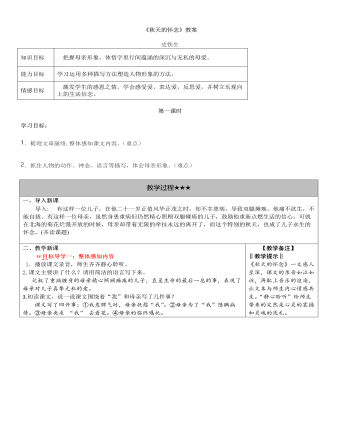
部编版语文七年级上册《秋天的怀念》教案
目标导学三:拓展理解1.几十年后,回忆起母亲,史铁生写下了这么一段话,请读一读,说说你读出了作者怎样的情感。那时的我,作为她的儿子,还太年轻,还来不及为母亲着想,我被命运击昏了头,一心以为自己是世上最不幸的一个,不知道儿子的不幸在母亲那儿总是要加倍的。她有一个长到二十岁上忽然截瘫了的儿子,这是她唯一的儿子;她情愿截瘫的是自己而不是儿子,可这事无法代替;她想,只要儿子能活下去哪怕自己去死呢也行,可她又确信一个人不能仅仅是活着,儿子得有一条路走向自己的幸福的路;而这条路呢,没有谁能保证她的儿子终于能找到——而这样的母亲,注定是世界上活得最苦的母亲。我感受到:作者对母亲的怀念、思念之情;作者对母亲的忏悔、懊悔、后悔、悔恨之情;作者对母亲的自责、内疚之情;作者自己的成长,完全理解母亲了……2.阅读课后练习四史铁生《我与地坛》中的同样是写母亲一段文字,说说它与课文在写法上有何不同。
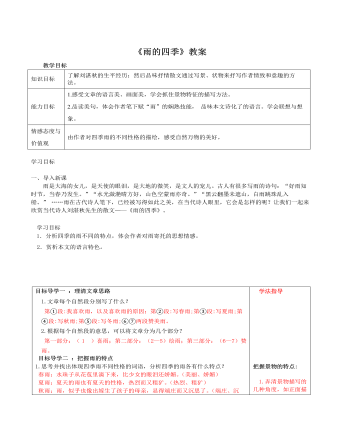
部编版语文七年级上册《雨的四季》教案
2.作为一篇优美的散文,本文在写景上有许多亮点,你认为春雨图中哪些亮点?①树:“树睁开特别明亮的眼睛”把树写活了,人格化了。②水珠:“水珠子从花苞里滴下来,比少女的眼泪还娇媚”,采用拟人的修辞手法,把水珠写活了,人格化了。把花苞滴下来的水珠子与少女的眼泪作比,说它比少女的眼泪还娇媚,使本来平淡无奇的自然现象拥有了人的神态和情感,写的形象生动。③水雾:或浓或淡的水雾映射着雨后的阳光,更映射着雨后的美丽世界。④小草:谁听过春草复苏、萌发、成长的声音?作者听到了。这沙沙声是真正热爱大自然、珍视生命、细心于生活的人用心灵听到的,运用比喻的修辞手法,生动形象的写出了小草在春雨的滋润下焕发出勃勃的生机。这美丽的文字是作者用细腻的心写出来的。⑤空气:空气本是无色无味的,平常到甚至让人忽视。可是在作者笔下空气却在春雨过后透出果子一样的芳甜,这正好可以和我们学过的一个句子互相诠释“清新的空气使我觉得呼吸的是香”。
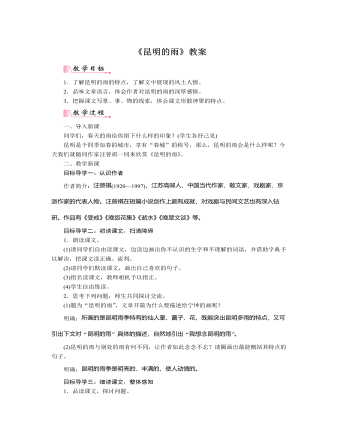
部编版语文八年级上册《昆明的雨》教案
2.思考下列问题,师生共同探讨交流。(1)题为“昆明的雨”,文章开篇为什么要描述给宁坤的画呢?明确:所画的是昆明雨季特有的仙人掌、菌子、花,既能突出昆明多雨的特点,又可引出下文对“昆明的雨”具体的描述,自然地引出“我想念昆明的雨”。(2)昆明的雨与别处的雨有何不同,让作者如此念念不忘?请圈画出最能概括其特点的句子。明确:昆明的雨季是明亮的、丰满的,使人动情的。目标导学三:细读课文,整体感知1.品读课文,探讨问题。(1)这样明亮又丰满的雨季自然是使人动情的。你体会到作者怎样的情感?明确:怀念、喜爱、乡愁。(2)你是从文中哪些词句之中体会出作者的这种感情的?明确:结合具体的写雨、物、人等的句子,让学生理解作者想念的不仅仅是“雨”,还有物、景、人、事,想念的是昆明的民风、人情和当年在那里的宁静、恬然的生活。
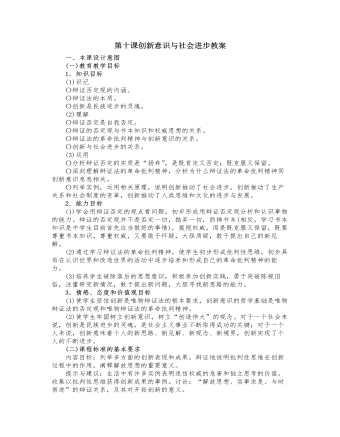
人教版高中政治必修4第十课创新意识与社会进步教案
2.辩证的否定(1)辩证的否定是事物的自我否定。事物内部存在着肯定方面和否定方面,它们既对立又统一。最初,肯定方面处于支配地位,否定方面处于被支配地位。在这种情况下,事物就被肯定着。但是,在矛盾双方的斗争中,否定方面总会由弱变强。一旦否定方面由被支配地位上升为支配地位,事物就转化到了自己的对立面,实现了对事物的否定。事物最终之所以被否定,根源在于事物的内部,是事物内部的否定因素战胜了肯定因素。因此,事物的否定是自我否定。(2)辩证的否定是事物发展的环节和联系的环节。所谓发展,是指新事物的产生和旧事物的灭亡。而实现这一过程必须要对旧事物进行否定,否定实现了事物由旧质向新质的飞跃。新事物在否定旧事物时,并不是把旧事物全盘抛弃,一笔勾销。旧事物是新事物的母体,新事物从旧事物那里脱胎而来,新事物是在批判地继承旧事物中的一切积极的有生命力的因素的基础上发展起来的。这样,在新旧事物之间就存在着必然的联系。
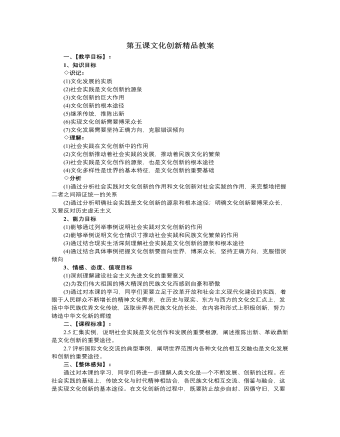
人教版高中政治必修3第五课文化创新精品教案
3.社会实践对文化创新的决定作用社会实践对文化创新具有两个方面的重要作用:(1)社会实践是文化创新的源泉实践,作为人们改造客观世界的活动,是一种有目的、有意识的社会性活动。人类在改造自然和社会的实践中,创造出自己特有的文化。离开了社会实践;文化就会成为无源之水、无本之木,人们不可能从事任何有价值的文化创造。◇本课小结:1.关于本课逻辑结构的宏观把握:文化创新的源泉和作用这一问题,教材分三个层次展开论证:一是不尽的源泉,不竭的动力;二是巨大的作用,深刻的意义;三是呼唤文化创新的时代。教材运用辩证方法从文化创新的源泉和作用展开论述。即社会实践是文化创新的源泉,文化创新又推动社会实践的发展和促进民族文化的繁荣。教材关于文化创新的途径问题,从三个层次展开讲述:第一个层次是“继承传统,推陈出新”;第二个层次是“面向世界,博采众长”;第三个层次是“坚持正确方向,克服错误倾向”。
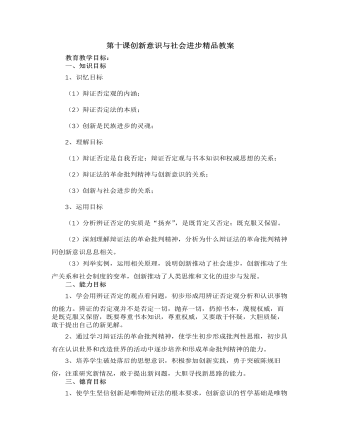
人教版高中政治必修4第十课创新意识与社会进步精品教案
在数学上,0这个数是解决记数和进位问题而引进的概念,由于它不能表示实在的东西,很长时间人们不把它看作是一个数。认为0是无,是对有的否定。从唯物辩证法的观点看,这种否定不是形而上学的简单否定,而是具有丰富内容的辨证否定。辨证的否定是发展的环节。0是从无到有的必经之路,是连接无和有的桥梁。0又是正数和负数之间的界限,它既否定了任何正数,也否定了任何负数,是唯一的中性数。但它又是联结正数和负数的中间环节。没有0,负数就过渡不到正数去,正数也休想发展到负数来。数学中的0是对任何定量的否定。如果没有这一否定,任何量的发展都无从谈起。这个否定不是一笔勾销,而是扬弃。因为它克服了任何定量的有限性,成为其发展的环节。在现实生活中,0作为辨证的否定,也体现出联系和发展的性质。如0度不是没有温度,而是非常确定的温度。
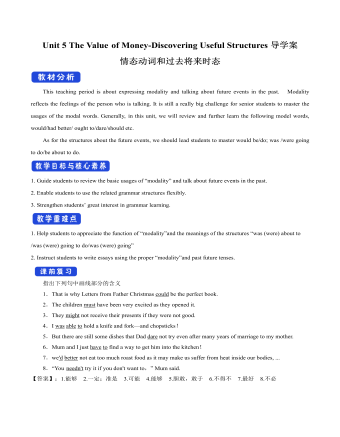
新人教版高中英语必修3Unit 5 The Value of Money-Discovering Useful Structures导学案
4.They were going to find someone to take part in their bet when they saw Henry walking on the street outside.[归纳]1.过去将来时的基本构成和用法过去将来时由“would+动词原形”构成,主要表示从过去某一时间来看将要发生的动作(尤其用于宾语从句中),还可以表示过去的动作习惯或倾向。Jeff knew he would be tired the next day.He promised that he would not open the letter until 2 o'clock.She said that she wouldn't do that again.2.表示过去将来时的其他表达法(1)was/were going to+动词原形:该结构有两个主要用法,一是表示过去的打算,二是表示在过去看来有迹象表明将要发生某事。I thought it was going to rain.(2)was/were to+动词原形:主要表示过去按计划或安排要做的事情。She said she was to get married next month.(3)was/were about to+动词原形:表示在过去看来即将要发生的动作,由于本身已含有“即将”的意味,所以不再与表示具体的将来时间状语连用。I was about to go to bed when the phone rang.(4)was/were+现在分词:表示在过去看来即将发生的动作,通常可用于该结构中的动词是come,go,leave,arrive,begin,start,stop,close,open,die,join,borrow,buy等瞬间动词。Jack said he was leaving tomorrow.
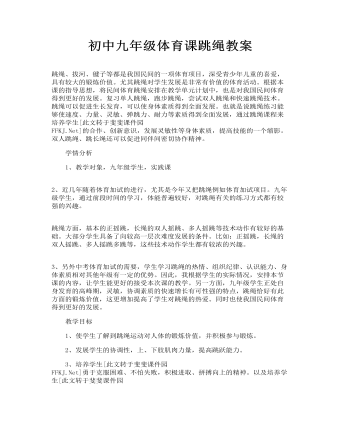
初中九年级体育课跳绳教案
1、教学对象,九年级学生,实践课 2、近几年随着体育加试的进行,尤其是今年又把跳绳例如体育加试项目。九年级学生,通过前段时间的学习,体能普遍较好,对跳绳有关的练习方式都有较强的兴趣。 跳绳方面,基本的正摇跳,长绳的双人摇跳、多人摇跳等技术动作有较好的基础。大部分学生具备了向较高一层次难度发展的条件。比如:正摇跳,长绳的双人摇跳、多人摇跳多跳等,这些技术动作学生都有较浓的兴趣。 3、另外中考体育加试的需要,学生学习跳绳的热情、组织纪律、认识能力、身体素质相对其他年级有一定的优势。因此,我根据学生的实际情况,安排本节课的内容,让学生能更好的接受本次课的教学。另一方面,九年级学生正处自身发育的高峰期,灵敏,协调素质的快速增长有可性强的特点,跳绳恰好有此方面的锻炼价值,这更增加提高了学生对跳绳的热爱。同时也使我国民间体育得到更好的发展。
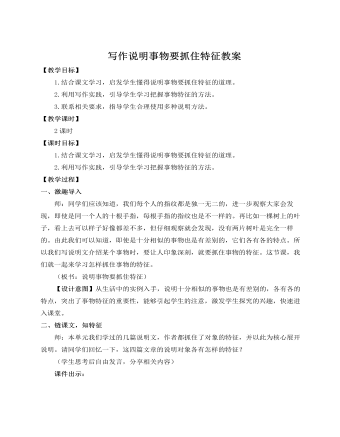
人教部编版语文八年级上册写作说明事物要抓住特征教案
广场为开放式,从四面都可进入,但在东北和西南各有一个木制长廊,上面缠络着紫藤萝,每到夜晚,这里点亮一盏盏小彩灯,与紫藤萝相辉映,煞是好看。广场正北对着的是公园管理处,共2层。南面是万福园芙蓉广场富强店,面积有4000多平方米,是一个超大型的商场。这就是我们的芙蓉广场,怎么样,很漂亮吧,有空来玩玩吧!生点评:何秀同学写芙蓉广场采用“总—分—总”的结构,开篇先点明广场的位置、特征,然后介绍得名原因、广场的规模地势,再按照游踪介绍,最后总结。全文采用多种说明方法,且融入情感,既让读者了解了芙蓉广场的有关知识,又表达了自己的喜爱之情。师点评:文章介绍群体建筑——广场,抓住芙蓉广场秀美、雅致的特点,重点介绍第一层主题广场,略写周边草坪及建筑,详略得当,层次分明。另外,作品采用“总—分—总”的结构,以游览的方式引导读者了解广场建筑,让文章生动亲切,也是作品的亮点。


